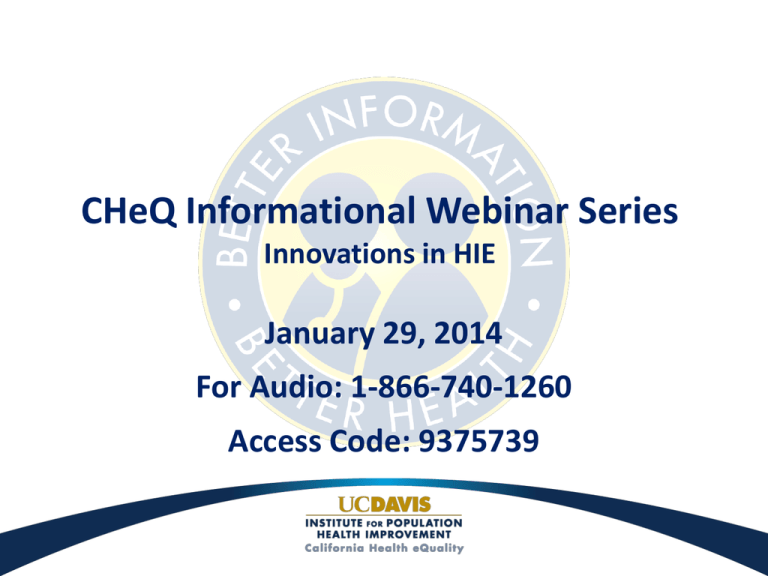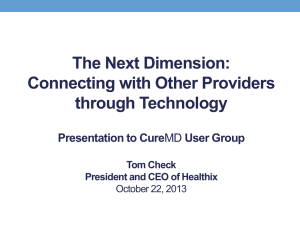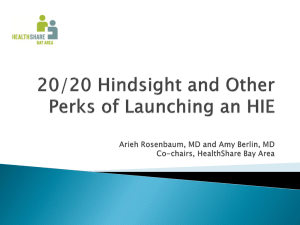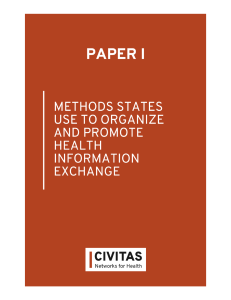CHeQ Informational Webinar Series January 29, 2014 For Audio: 1-866-740-1260 Access Code: 9375739
advertisement

CHeQ Informational Webinar Series Innovations in HIE January 29, 2014 For Audio: 1-866-740-1260 Access Code: 9375739 California Health eQuality Program (CHeQ) Implementing California’s Health Information Exchange (HIE) programs with California Health and Human Services Agency (CHHS), under state’s Cooperative Grant Agreement with federal Office of the National Coordinator for Health Information Technology (ONC) CHeQ promotes coordinated health care for Californians by catalyzing the adoption and implementation of Health Information Exchange by: – Building a trusted exchange environment that enables inter-organizational and interstate exchange while respecting and protecting patient privacy – Supporting uniform standards for exchanging health information – Improving public health capacity – Accelerating HIE implementation by supporting regional HIE initiatives 2 Innovations in HIE Series http://www.ucdmc.ucdavis.edu/iphi/Programs/cheq/cheqinnovations.html Session 1: Innovations in Data Analytics – National Rural ACO – Lynn Barr – Tuesday, January 7th at 10am Session 2: Innovations in HIE for Special Populations (Foster Children) – The Children’s Partnership – Beth Morrow and Kiki Nocella – Tuesday, January 14th at 10am Session 3: Innovations in Patient Access (Blue Button) – LA Care – Ali Modaressi – Tuesday, January 21st at 10am Session 4: Findings from CHeQ’s HIE Survey of CA Community Clinics – Kathy Kim – Tuesday, January 28th at 10am Session 5: Innovations in HIE for Behavioral Health – OCPRHIO – Paul Budilo – Wednesday, January 29th at 10am Orange County Partnership Regional Health Information Organization, Inc. OCPRHIO Sensitive & Behavioral Health Information in HIEs January 29th, 2014 1/29/2014 Better patient care through innovation. 4 Better patient care through innovation. Agenda The Evolution of HIEs Sensitive Health Information and HIEs Project Background and Approach Results and Recommendations Lessons Learned 1/29/2014 5 Better patient care through innovation. Some of the Project Team 1/29/2014 6 Better patient care through innovation. The Evolution of HIEs and Sensitive Health Information A few years ago HIEs were in their infancy Resistance to participate Hesitation to share information Who is seeing my data? My patient Panel Technical & legal issues 1/29/2014 7 Better patient care through innovation. Better patient care through innovation. Fast forward a few years….we have evolved… Let’s try to figure this out Better patient care through innovation. Project Background and Approach Working Together Overall Objective: To see if the roadblocks of providing sensitive patient health care information in an HIE still exist. Are they legal or technical? If possible, integrate the information to make it available to others. If not, then identify the Lessons Learned 1/29/2014 9 Better patient care through innovation. Project Phases Step 1. Environmental Scan and Requirements Review Understand the requirements for successful exchange of sensitive patient information such as behavioral health information (BHI) Step 2. Integrate Behavioral Health Information within di OCPRHIO Integrate a behavioral health clinic into Orange County Partnership Regional Health Information Organization, Inc. (OCPRHIO) to meet these requirements Step 3. Pilot Test Data Exchange 1/29/2014 Pilot test exchange of BHI within this environment so that this is reproducible in other community health information organizations (HIOs). 10 Better patient care through innovation. Environmental Scan: Bronx RHIO one of 10 RHIOs in the State of New York. Key Points: Bronx RHIO developed Policies and Procedures to guide governance and policy issues like Consent, and to establish how RHIOs would connect with each other; what the core services of a RHIO should be, and other issues to promote HIE in New York. RHIOs agree to almost a state-wide Consent Model Form with modification. NY is an Opt-in State. Bronx RHIO was first in the state to collect Consent at the local level to be communicated with the RHIOs through ADT messages. Consent is set; clinician has a short turnaround to access RHIO. New York has a default status -- if never asked, and in an emergency, can Break-the-Glass. The “All In” concept recognizes that there was no way to segment the data. Due to the requirements of the Substance Abuse and Mental Health Services Administration (SAMHSA), many facilities governed by SAMHSA chose not to become data sources to the RHIOs. This is one kind of data that RHIOs in NY worked to block. SAMHSA vs. non-SAMHSA governance is based on location, not on the data. Substance abuse exchanges in a general care area is not governed by CFR 42 Part 2. Part 2 Compliant Consent Form must specify substance abuse program, with language that clarifies, “alcohol or drug use programs which you are in now or were in before as a patient.” 1/29/2014 11 Better patient care through innovation. Environmental Scan: SCHIE one of 22 HIEs in the State of California. Key Points: Bill Beighe, Chief Information Officer, Santa Cruz HIE SCHIE’s current policy is to re-enforce not sharing certain data. SCHIE does share data without the properly signed authorization. It is done within the Center’s control to obtain a signed authorization. There is a manual process to gain signed authorization. The protocol followed for disclosing data is performed by humans, not by a system. Reliance on human-end behavior is based on: • Receiving a signed authorization from the patient • Sending data to whomever authorization is allowed • If someone from outside wants a request, ensure message to BH is secured Human looks at request and follows through 1/29/2014 12 Better patient care through innovation. Environmental Scan: SDRHIE one of 22 HIEs in the State of California. Key Points: Dan Chavez, Executive Director, San Diego Regional HIE San Diego Regional HIE, reports that currently, SDRHIE does not include BHI on their HIE Providers are currently not sending sensitive patient information. The physicians don’t want to wait for the consent, and want the data sooner, rather than later SDRHIE has implemented a policy work group to discuss inclusion of BHI and other sensitive patient information : • The work group will review and approve findingsIf someone from outside wants a request, ensure message to BH is secured Human looks at request and follows through 1/29/2014 13 Better patient care through innovation. Future Plans for OCPRHIO Patient Consent Patient Consent • The responsibility of the provider and NOT the HIE • Multiple Consent forms are still being used • Some attorneys involved in the project approved of a single form for multiple consents……other attorneys did not! • Electronic Consent…move to this is growing and available with some providers, MAJORITY are still paper-based 1/29/2014 14 Better patient care through innovation. Lessons Learned Today’s solutions are all best-possible in a less than perfect situation Sensitive data is a subjective decision Issues are not just legal/technical, but even more than that….it is sensitivity and best practices Design and adopt a universal consent form to be used by all California HIEs Transition from paper-based process to an electronic integration process 1/29/2014 15 Better patient care through innovation. Lessons Learned – Cont’d Educate and train admission staff to verify and enter Consent data accurately into EHRs. Standardize Break the Glass protocols IMPORTANT…Engage California’s HIEs to collectively make the needed changes to adopt BH processes. Design and adopt a universal consent form to be used by all California HIEs VA is piloting approaches how to handle sensitive health information which includes data segmentation and granular consent 1/29/2014 16 management Better patient care through innovation. Q&A What Questions May We Address? 1/29/2014 17 Orange County Partnership Regional Health Information Organization, Inc. Thank you for your time and interest ….. Better Patient Care Through Innovation 1/29/2014 18 Thank you for advancing HIE and improving patient care in California 19 Thank You! For more information, please contact: Paul Budilo – pbudilo@ocprhio.org http://www.ucdmc.ucdavis.edu/iphi/Programs/ cheq/cheqinnovations.html 20





